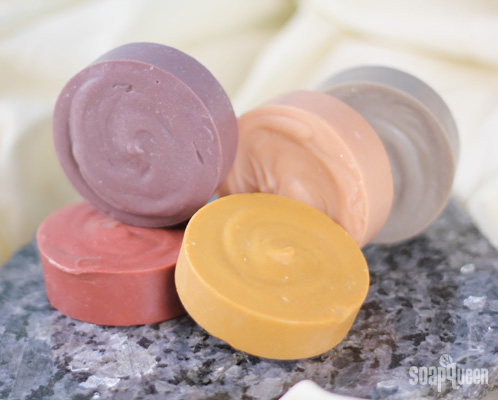It’s been many years since I learned the ins and outs of percentages, ratios and parts. I get plenty of practice playing with them though since almost every day is a soap day around here (lucky me!). It is one of the more common questions that our stupendous team gets whenever soapers are trying to calculate parts (whozit? whatzit?!), resize batches or try to figure out if they have too much (or too little) coconut oil in their recipe.

Bramble Business Series: Navigating Pinterest
Within the past few years, photo-sharing website Pinterest has emerged as a haven for DIY-enthusiasts. With so many beautiful images and fun tutorials, it’s easy to spend an entire afternoon browsing. It’s no wonder then that is has also emerged as a full-blown way to successfully market and sell homemade bath & body products. We’re continuing our Bramble Business Series today with an overview of Pinterest and how to use it to your advantage.

Soap Behaving Badly
I started my soaping adventures when I was young (ah, sweet 16), and have learned that not everything turns out perfectly the first time. Sometimes despite your best efforts during a soaping session, you’ll get batches that just don’t quite turn out right. It’s just an inherent (and disappointing!) part of soaping. I’m a firm believer in ‘practice makes perfect,’ and being persistent in mastering your technique will help you achieve what you want in your soap, consistently. While there are hundreds of soaping variables that can cause problems, one huge factor that can determine the success of your soaping session is the fragrance or essential oil you use.
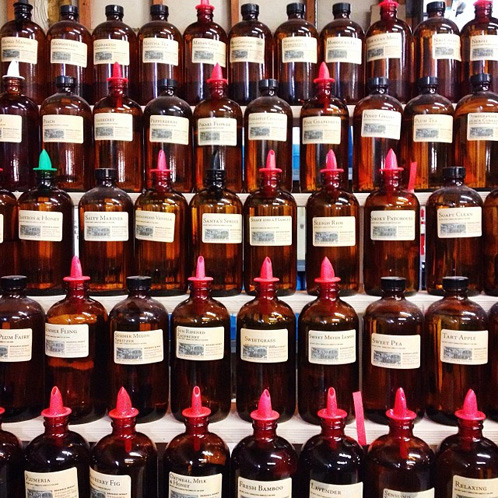
All Bramble Berry Fragrance and Essential oils go through a thorough testing process to ensure they perform well in cold process soap.
Selling Success at Fairs and Public Markets
By now the holiday craft season is in full swing, and you may be experiencing a bit of “seller’s fatigue” – it can be exhausting remembering to pack all your supplies, set up and take down your display, and be on the ball and ready to go week after week. Bronwyn Bacon, a soapy enthusiast who has worked in customer service and business management for more than a decade, has amassed a wealth of tips and advice for being successful at craft fairs and markets. Read on to learn how to sell for success! — A-M
Before You Go
If you’re still new to fairs, I strongly encourage you to set up your booth at home (or in your backyard) from top to bottom. Don’t guesstimate on how much time you’ll need; by setting it up for real, you’ll know exactly. Just to be super prepared, add a half hour for “issues” that always seem to crop up. Once you have as much of your booth set up as you can and it’s arranged to your liking, take photos so you have a reference to easily recreate your setup.
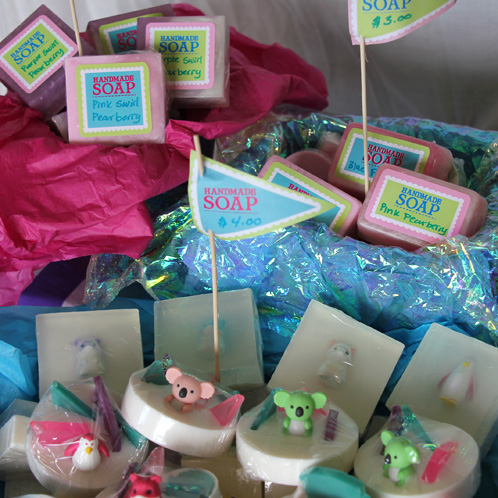
Expect the unexpected when taking your products on the road. Time yourself so you know exactly how long it takes you to set up and tear down your displays.
The Ultimate End-of-the-Year Business Inspiration guide
It’s been more than a year since our last business post mash-up (wow, time sure does fly!) and over that year we have amassed a whole collection of business tips, inspirational ideas and insightful interviews with fellow soapers. We hope that this post will serve as a comprehensive resource of soapy inspiration to help power you through this busy craft season.
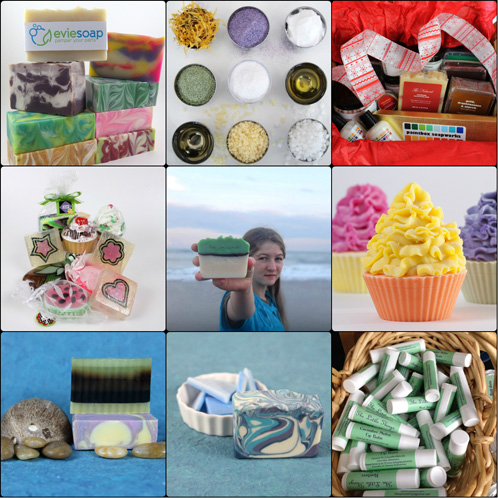
I love chatting with fellow business owners, and we had the opportunity to interview nine talented soapers this year. From cold process soapers to melt and pour experts to seasoned business owners to those who are just starting out, with these interviews you’ll get a range of perspectives from soapers across the business spectrum.
Top Row: EvieSoap, Realize Beauty, & Paintbox Soapworks
Middle Row: Kokolele Soaps, Suds by the Sea, & Jennifer’s Handmade Soaps
Bottom Row: Shaka Soap, Missouri River Soap & Little Things Store
Have you ever thought about starting a business or need help with some aspects of your social media plan? Check out the Bramble Business Series posts. You can learn about to Set up an Etsy Shop, Use A Twitter Handle, How to set up a WordPress Blog and How to Set Up A Facebook Business Page. Don’t forget to check out the Best Business Practices: Facebook post to learn more about the do’s and don’ts of social media.
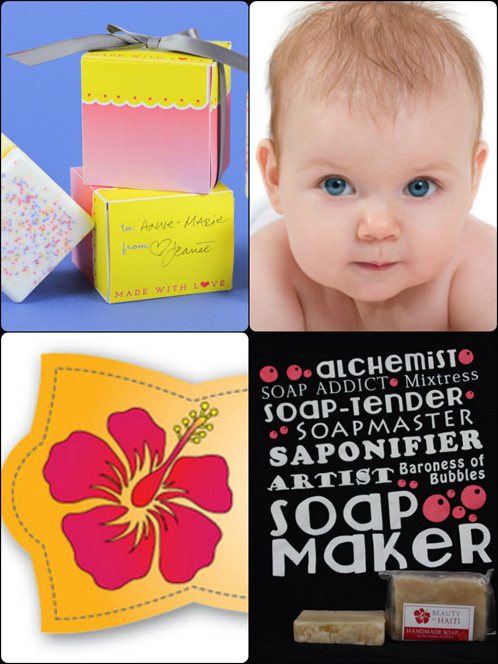
Top Row: Finding your Niche & On Babies and Business
Bottom Row: Beauty in Haiti & Thank you from Haiti
We’ve also had a few guest posts from soapers such as Amanda Griffin from Lovin’ Soap about her trip to Haiti and her amazing new non-profit; Donna Maria from the Indie Business Network; and Jeanee Duval from Dirty Laundry. Jeanee was also our guest for two Soap Queen TV videos which you can watch here and here.
I’ve also been busy keeping up on some of the legal issues in the handmade industry and discussed the Product Labeling Change: Physical Address Petition that was filed earlier this year by the Handcrafted Soap & Cosmetic Guild. California also got a bit of press with a proposed Safer Consumer Product regulations, and Etsy updated their policies on cosmetics making claims.
Be sure to also check out these general business posts on everything from Bramble Berry’s Palm Oil to How to Photograph Products and more.

Top Row: Craft Show Tips Galore, Does It Get Easier?, Go with the Flow
Middle Row: Dealing with Unhappy Customers, Why a Newsletter is a Must, Switchtasking,
Bottom Row: How To Photograph Products, On Palm Oil, Visualizing Success
Want more business inspiration? Check out our previous business compilation posts: Business Management, Interviews & Inspiration and Marketing.
Do you have pressing business-related question? Let us know below!
How to Handle Potassium Hydroxide
When making soap from scratch, there’s one thing you just can’t avoid: lye. Without lye, your soap just isn’t soap! Working with lye may seem daunting at first, but if you learn proper handling techniques, take precautions and follow basic safety guidelines, there is no reason to fear it. You may be familiar with Sodium Hydroxide, which is used to make solid cold process soap, but today we’ll cover Potassium Hydroxide, which is used exclusively in liquid soap. Although the rules for working with Potassium Hydroxide are similar to working with Sodium Hydroxide, it is important to understand and recognize the differences. Plus, it’s always nice to have a general lye safety refresher! To learn more on general lye safety, check out this blog post.
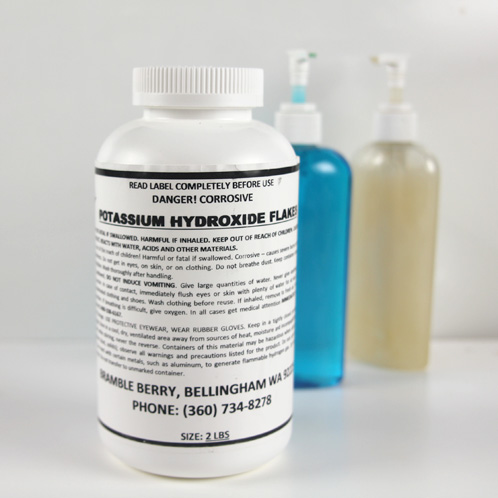
Potassium Hydroxide is a type of lye specifically used to make liquid soap. It is also known as potash, lye or even KOH. This is the chemical that induces saponification of the fats and oils to create liquid soap. Even though making liquid soap is different than making bar soap, it’s still vitally important that you use the correct amount of lye in your recipe. Our lye calculator makes this easy and allows you to select liquid soap as an option.
Potassium Hydroxide is hygroscopic (meaning it attracts moisture), so be sure to keep it in a sealed container in a cool dry place. If you leave it in an open container for even a day, it can attract enough moisture to throw off its weight enough to ruin a recipe. If you leave it out for an extended period of time, it can attract enough moisture from the air in the room to turn completely liquid. When handling Potassium Hydroxide, give it the same safety considerations as you would with Sodium Hydroxide. It is a hazardous material, and being educated about safe handling practices is key when handling Potassium Hydroxide. As with any other type of lye, Potassium Hydroxide will emit some fumes, so be sure to soap in a well-ventilated area.
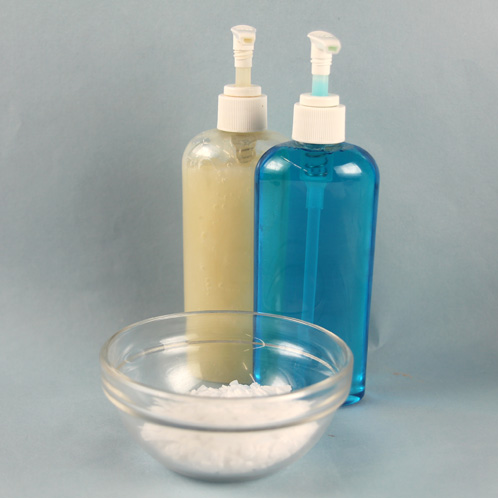
Always add your lye to your water, and never the other way around. Adding water to lye can cause a volcano-like reaction. Unlike Sodium Hydroxide, Potassium Hydroxide reacting with water makes a faint crackling or groaning sound — a somewhat subtle version of adding milk to Rice Krispies cereal.
When working with lye water, wear goggles that protect your eyes from all sides because alkali burns can cause blindness. If you wear glasses, check your local hardware store for goggles that are big enough to fit over them. Always wear an apron and gloves. Rubber dish gloves are great, but if they’re too bulky you can use thinner latex gloves. Pair your gloves with long sleeves because the less exposed skin you have, the better. Finally, use a heat safe container to hold your lye water, and use silicone or stainless steel tools to stir (no wood). Never use any tools or bowls containing aluminum as that will create highly flammable hydrogen gases. Remember that when Potassium Hydroxide is mixed with water, it produces a reaction that heats the water up substantially, making it all the more important to mix lye in a heat safe container.
Never leave your lye water (or lye) unattended or in an place where children or pets may come in contact with it. It only takes a few seconds for an accident to happen! If you do need to leave the lye unattended for whatever reason, cover the container with a piece of plastic wrap and use a sticky note to clearly label it as a hazard.
If there is an accident:
If swallowed: Rinse mouth with water and drink one or two class of water. Do not induce vomiting! Immediately get medical attention or call your poison control center at 1-800-222-1222.
If in eyes: Immediately flush eyes with water. Remove any contact lenses and continue to flush eyes with water for at least 20 minutes. Immediately get medical attention or call your poison control center at 1-800-222-1222.
Lye water on skin: Wipe solution from skin and remove any contaminated clothing. Flush skin with plenty of water for at least 15 minutes and then wash thoroughly with soap and water. Contact a physician or call your poison control center at 1-800-222-1222.
Raw soap on skin: Even after it has been mixed with oils, lye can still be dangerous. If exposed skin comes in contact with raw soap batter, flush with water for 5 minutes and then wash thoroughly with soap and water.
Just like any tool, Potassium Hydroxide can be used safely and carefully to create wonderful liquid soaps for personal or business use. Use it responsibly.
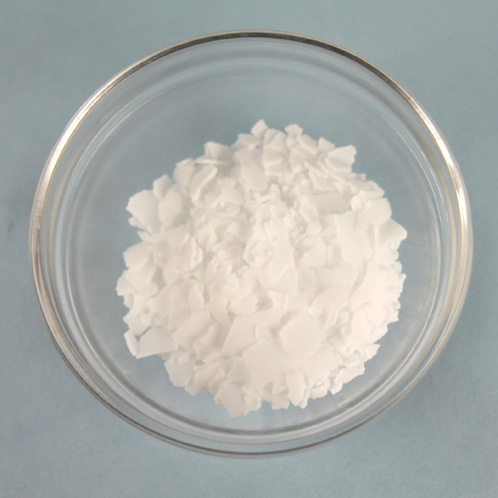
What are you experiences working with Potassium Hydroxide? Let us know your best tips and tricks to work with it in the comments below!
Facebook Photo of the Week (August 30th ~ September 6th)
Happy September! This week started off with the beginnings of a wet and windy Pacific Northwest fall, which made us long for hot cocoa, warm sweaters, and the holidays (it’s never too soon to celebrate!). If you are looking to bring on the fall spirit, try out our Falling for Pumpkin Pear or Apple Jack Peel Cold Process Soap Tutorials. In the spirit of fall and the return to school for so many, we have a special young guest for this week’s Facebook Photo of the Week. Read on to find out more about this amazing soaper.
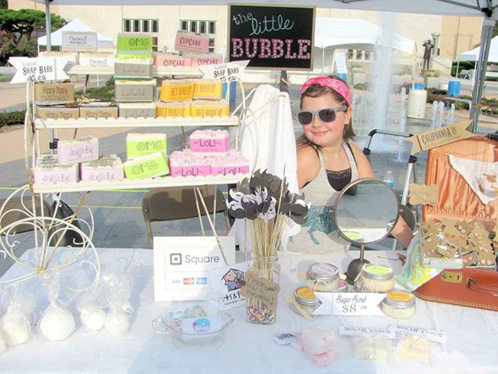
This week’s absolutely adorable photo comes to us from Bella, a 9-year-old entrepreneur and owner of The Little Bubble. Her excellent set up caught my eye. Her prices are clearly visible, the table is clean and professional, and her products are beautifully packaged. With this booth, she is setting herself up for success!
Bella has been working hard all summer using Bramble Berry products to create some fantastic soaps. Even while in school, Bella diligently jots down ideas for new soaps. Thank you so much for being part of our amazing soapmaking community on Bramble Berry’s Facebook page, Bella, and be sure to watch out for a special little package headed your way!
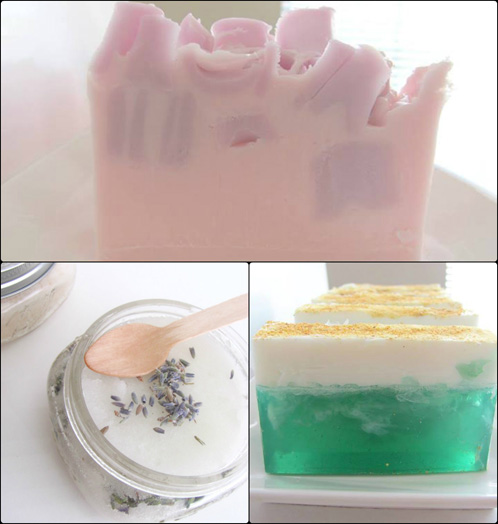
Bella’s Facebook Page: The Little Bubble
Bella’s Store: The Little Bubble
Post pictures of your soap creations on the Facebook page each week for a chance to be featured on the Soap Queen blog (as well as receive a sweet soapy package from Bramble Berry).
Bramble Business Series: How to Set Up A Facebook Business Page
This week in the Bramble Business Series we are going to talk about one of the easiest ways to market your business — setting up a Facebook business page. In this post, you will get a quick introductory tutorial on how to create your Facebook business page and more about how you can use your business page to showcase your products. If you’ve missed the first post in our series, How to set up an Etsy Shop, be sure to check it out and learn how to set up an online storefront through Etsy. Have any tips or tricks of your own to share with us? Leave a comment below.
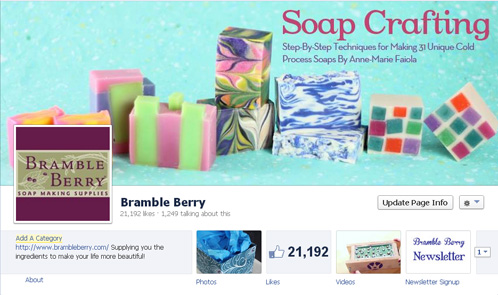
A Facebook business page is an easy and free way to represent your business online and put your products in front of future and potential clients. On Facebook, you can create a Business Page here. Now get ready to follow along as we walk you through how to set it up step-by-step! (P.S. Already have a Facebook Page? Skip over to our post about Facebook Best Practices to learn how to manage it effectively!)
ONE. Congrats! You’ve chosen to create a business page and we are here to guide you through it. Make sure you are on your own Facebook account before clicking the link HERE to make your own page. While all the pages you create on Facebook will be attached to your personal account, there are privacy settings that you can set up to make sure your personal information isn’t attached to your business page.
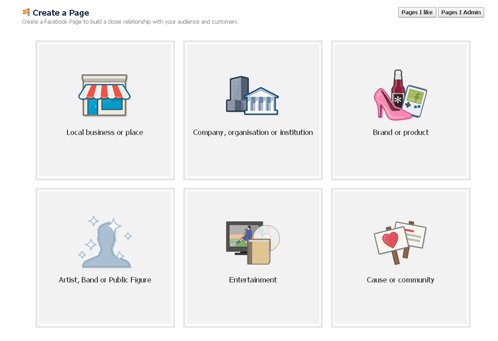
TWO. At this point, you can choose what type of page you will be creating. For the ease of this tutorial, we’ll go with the first choice that most (if not all) of you will be using. Click on the first square with the image of the storefront that reads ‘Local business or place’. From here, fill out the necessary information — the category (small or local business), your business name, the address of your business as well as your city and postal code. The phone number is not required, but can be useful if you want to provide your customers with any sort of customer service. Once you’ve filled out the proper information, make sure to check the little box that says you agree to the Facebook Pages Terms and click the blue button to Get Started!
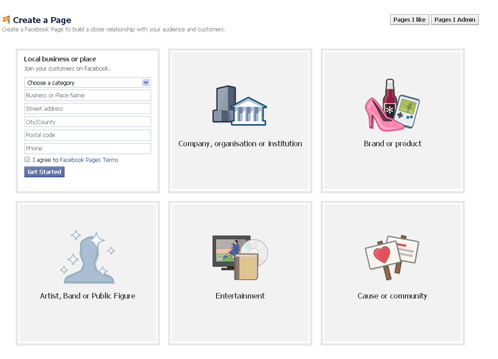
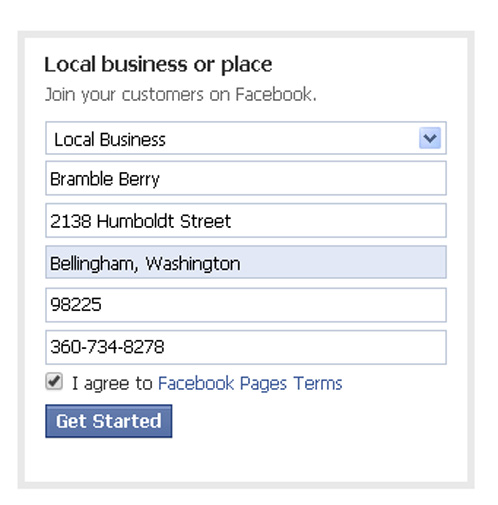
THREE. Now you get to fill out some the basic information about your business. In the about section, you will include a clear and concise description of your business and the products you are selling. If you already have a Website, Pinterest, Twitter, Blog or Instagram, you can add it in this section as well. Make sure all links are spelled correctly as you wouldn’t want a customer to click on your store or blog link if the URL is incorrect or missing.
Choose a name for your Facebook page, but remember: just like your Etsy shop, this name cannot be changed and you want it to be something that you’ll be happy with several years down the road. Once you’ve chosen your page name, the URL to your personal business page will read www.facebook.com/yourpagenamehere. For an example, notice the URL of the Soap Queen and Bramble Berry Facebook Pages: www.facebook.com/soapcrafting and www.facebook.com/BrambleBerry.
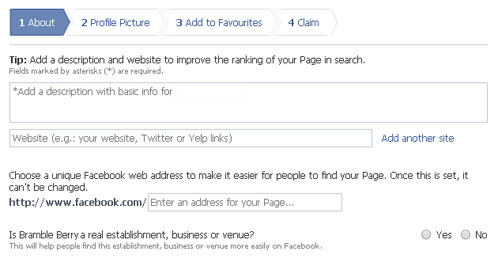
FOUR. You are almost done! This next part is actually one of my favorites — adding business images! You can choose a ‘profile’ picture for your page, which could be something like a logo or graphic to represent your business. You want to make it easily recognizable, brand-able and make sure you use your own images (anything that has a copyright cannot be used here). Be sure to run your profile by family and friends to get their feedback, they are great resource. Choose and upload the photo and that you would like to represent your profile picture and click next.
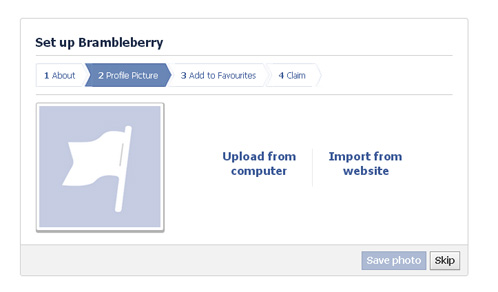
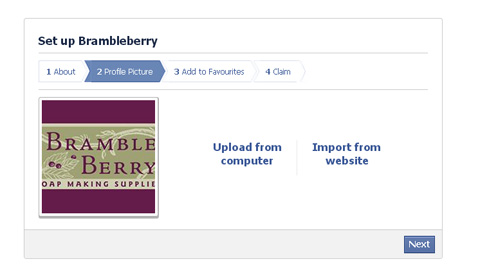
FIVE. (OPTIONAL) This second to last step is completely optional, but I suggest doing it so you will always have easy access to your Facebook page if you’re on a mobile app or a PC. If you would like to add your newly created page to your favorites, just click that big green button. If not, you can skip this step and add it at a later time.

SIX. You are done! Finish up the last step of the process by claiming your page and authorizing yourself to represent your business. Now comes the fun part of customizing your Facebook page with the graphics, imagery and words you want to use to represent your business. Don’t forget to add information to your About Page so that potential customers can learn more about who you are and what you do. You can even add related websites and social media platforms in this section. Remember to choose a cover photo that represents your brand and showcases your products and services as this will be the first thing people will see when they visit your page. To get inspiration for your photos and page setup, check out the fun soapy pages Bramble Berry has liked here.
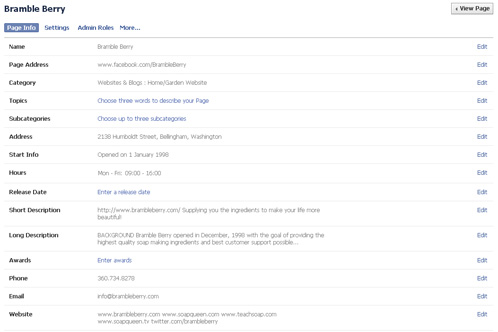
About Facebook Business Pages
- Personal Pages Versus Business Pages. I highly encourage you to create a Facebook Page for your business as Facebook’s terms of service actually prohibit using your personal profile for your own commercial gain as well as creating more than one personal profile. In fact, when I was first starting out on FB years ago, I made that rookie mistake and tried using a personal page to sell Bramble Berry products. Because of this, I had my page shut-down and had to start over. This is something you should avoid! Having a business page gives you more freedom to offer your products for sale as well as hosting contests and giveaways.
- Followers. Followers or ‘fans’ are an integral part of growing your business on Facebook. You grow fans by offering products people want, sharing images people enjoy, blog posts or other relevant or interesting links related to your industry. One thing I don’t suggest is ‘buying’ your likes. This is a very unethical practice and won’t actually show how many true fans you have. Grow your business organically and working hard to get each and every ‘like’ helps you build a truly loyal customer base.
- Analytics. You have a place to share your photos, blog posts and products on Facebook, the web’s largest social media sharing site. Facebook has also introduced these snazzy new analytics so you can track followers and likes over time, see what posts get the most attention and more.
Now that you’ve got a Page, you’ve got to run it! For tips on how to keep customers coming back again and again and to make your page a hub of activity, check out our Facebook Best Practices post. Happy Facebooking!
Why Does Your Soap Cost So Much?
Wow! Thanks for the awesome response yesterday to the Craft Show Questions. A few commenters asked how to answer the questions that I posed.
Let’s have a discussion about that!
Here’s how I would answer the first question. If you have any thoughts on how YOU would answer or think that there is more to add from my question, please feel free to post your thoughts and suggestions as a comment. If you use this script, make sure you have a few main points that you memorize. This way, you can make it personalized with your flair and also shorten it as needed.
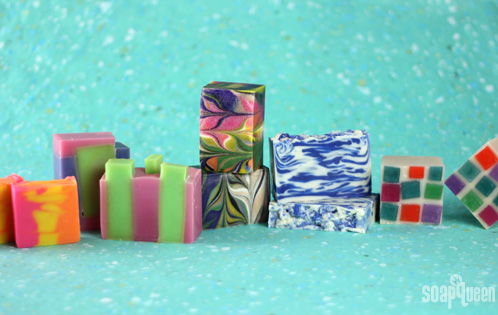
(when they give you a disbelieving look, head into this section)
“Seriously! That’s why you need to use lotion each and every time you use that fabulous (insert big company name soap here). My soap uses skin loving oils like coconut, palm and sweet almond oil to produce a perfectly balanced cleansing bar that leaves your skin moist, clean and smooth to the touch when you get out of the shower.”
“In addition to that, I use only fragrances, colors and herbs that have been approved for use on skin and high quality ingredients cost a little more. I make everything in small batches to ensure that the product you’re getting today is the best thing that you could possibly use on your skin. And, you’re helping to save the environment by buying from me instead of (insert big company here). Did you know that they make all of their soap over in Asia? Think of the environmental cost of getting all of that soap made there and shipped over here!”
“My soap is also very hard and should last as long or longer than the commercial soap. Plus, doesn’t it smell so much better to you?”
“Finally, when you purchase from the little guy (me!), you’re supporting a better economic way of life. Did you know that little small businesses just like me contribute more to our local economy because dollars spent with me stay in our community, helping to make our community stronger? Small business is the backbone of American society (though you couldn’t tell through the big subsidies the government gives to big business!) and employs the bulk of the American workforce AND provides the majority of the tax base.”
“So, you’re not only paying for a better way to do business that makes this community stronger but you’re paying for a better bar of soap that is healthier for your skin, your family and the environment.”
“How many bars would you like? (make sure you ASK for the sale after going through all of that) I have a deal where if you guy 4 bars, it’s just $16 plus tax. They keep for a long time and also make perfect gifts.”
